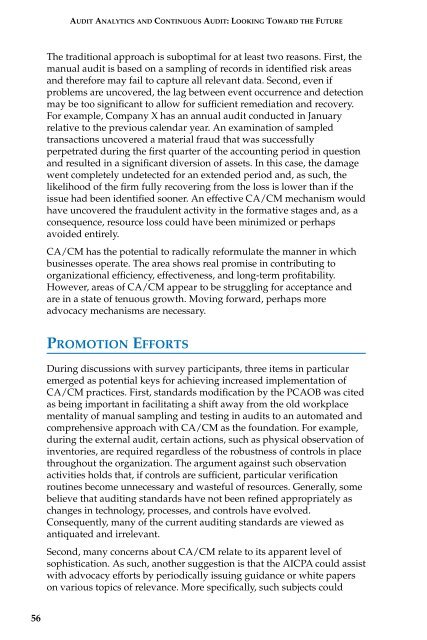AUDIT ANALYTICS AUDIT
1JWn3ix
1JWn3ix
You also want an ePaper? Increase the reach of your titles
YUMPU automatically turns print PDFs into web optimized ePapers that Google loves.
<strong>AUDIT</strong> <strong>ANALYTICS</strong> AND CONTINUOUS <strong>AUDIT</strong>:LOOKING TOWARD THE FUTURE<br />
The traditional approach is suboptimal for at least two reasons. First, the<br />
manual audit is based on a sampling of records in identified risk areas<br />
and therefore may fail to capture all relevant data. Second, even if<br />
problems are uncovered, the lag between event occurrence and detection<br />
may be too significant to allow for sufficient remediation and recovery.<br />
For example, Company X has an annual audit conducted in January<br />
relative to the previous calendar year. An examination of sampled<br />
transactions uncovered a material fraud that was successfully<br />
perpetrated during the first quarter of the accounting period in question<br />
and resulted in a significant diversion of assets. In this case, the damage<br />
went completely undetected for an extended period and, as such, the<br />
likelihood of the firm fully recovering from the loss is lower than if the<br />
issue had been identified sooner. An effective CA/CM mechanism would<br />
have uncovered the fraudulent activity in the formative stages and, as a<br />
consequence, resource loss could have been minimized or perhaps<br />
avoided entirely.<br />
CA/CM has the potential to radically reformulate the manner in which<br />
businesses operate. The area shows real promise in contributing to<br />
organizational efficiency, effectiveness, and long-term profitability.<br />
However, areas of CA/CM appear to be struggling for acceptance and<br />
are in a state of tenuous growth. Moving forward, perhaps more<br />
advocacy mechanisms are necessary.<br />
PROMOTION EFFORTS<br />
During discussions with survey participants, three items in particular<br />
emerged as potential keys for achieving increased implementation of<br />
CA/CM practices. First, standards modification by the PCAOB was cited<br />
as being important in facilitating a shift away from the old workplace<br />
mentality of manual sampling and testing in audits to an automated and<br />
comprehensive approach with CA/CM as the foundation. For example,<br />
during the external audit, certain actions, such as physical observation of<br />
inventories, are required regardless of the robustness of controls in place<br />
throughout the organization. The argument against such observation<br />
activities holds that, if controls are sufficient, particular verification<br />
routines become unnecessary and wasteful of resources. Generally, some<br />
believe that auditing standards have not been refined appropriately as<br />
changes in technology, processes, and controls have evolved.<br />
Consequently, many of the current auditing standards are viewed as<br />
antiquated and irrelevant.<br />
Second, many concerns about CA/CM relate to its apparent level of<br />
sophistication. As such, another suggestion is that the AICPA could assist<br />
with advocacy efforts by periodically issuing guidance or white papers<br />
on various topics of relevance. More specifically, such subjects could<br />
56


